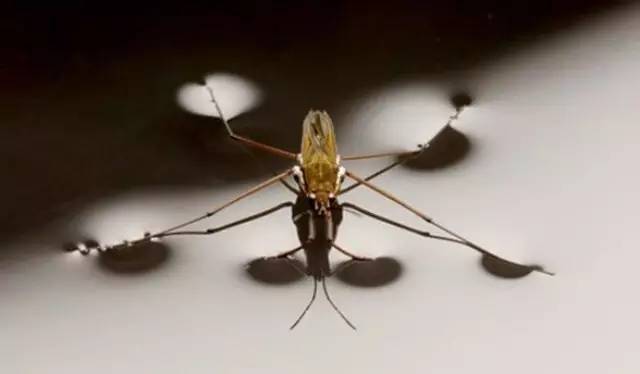
Why can insects stand on the water?
For small objects, surface tension can have a very different effect.
some bugs can stand and walk on the water, such as the one in the picture.
Metal paper clips sink to the bottom in water, but if you put them carefully on the water, you can let them float on the water:
Why? The main reason is that they are small enough. When the size of the object is small to a certain extent, the surface tension will produce a quite powerful effect.
what is the surface tension? In a uniform substance, the force of the molecule in all directions is also relatively uniform, but on the surface the situation is different. Take the interface between water and air, for example, the forces of the water molecules on the outermost surface are uneven, and the forces of the internal water molecules on them are greater, while the forces of the molecules in the air are much smaller, thus creating a force on the surface that tends to pull the surface back.
A large object can travel freely on the interface between water and air, but objects with sufficiently small heads are more likely to be blocked, which is actually caused by the bending of the liquid surface. No matter which side it passes through, when the object wants to pass through the interface between water and air, the liquid surface will bend to a certain extent, and the surface tension will pull the liquid surface back and create a resistance to prevent the object from passing through.
this picture shows the process from the water to the surface, and vice versa. During the bending of the liquid surface, the magnitude of the additional resistance caused by the surface tension is related to the degree of bending of the liquid surface. For large objects, the bending of the liquid surface is low, so the corresponding force is smaller, while smaller objects face a more curved liquid surface and greater resistance relative to their own size. For water, when the diameter of an object is about 3 mm, the blocking effect of the water surface on it is already obvious.
Dress and appear sumptuous in our fashionable wedding dresses under 200. Our magnificent garments will hugely boost your confidence.
for the insects and paper clips mentioned above, this force generated by surface tension is also the key to preventing them from passing through the water.
for some plankton in the water, it is difficult to break through this barrier if not fast enough to get from the water to the air.
this is a water flea that can't swim out of the water.
and if you want to rush out of the water, you have to make a quick impact like this one:
this property of curved liquid surface is also related to many common phenomena, such as capillarity. in fact, it is "pulled" by a concave curved liquid surface. Such a force is called the additional pressure on the curved liquid surface.
although there is an annoying feeling of reviewing physical chemistry, the superficial phenomenon is still very interesting and can explain many phenomena of life. I wonder if I have explained clearly _ (: bending ") _
PS: there is another common phenomenon involving curved liquid surface, that is, superheated liquid, which still does not boil after it exceeds the boiling point temperature. And when disturbed, it may suddenly start to boil violently. I have written this a little before, and you can check it if you read the original text.
PPS: forgot to mention yesterday that last week's most popular article was about the Leighton Frost phenomenon, and the reply [droplet Dance] can be found.